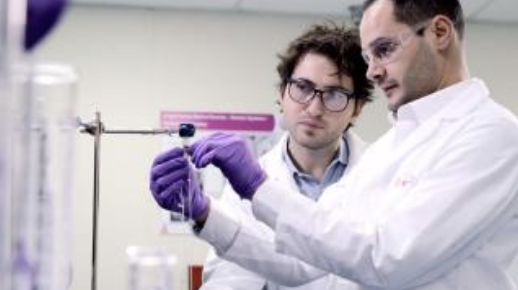The Magnet App Attracts More Collaborative, Productive, and Efficient Office Environments
Q: What prompted Deloitte to develop the Magnet app?
Chris Dinkel (CD): Deloitte Consulting constitutes over half of Deloitte’s US operations, and Deloitte Advisory is getting close to being a quarter of US operations. That means that three quarters of all US-based Deloitte employees are essentially on the road every week and rarely in the office. That translates to a tremendous amount of unutilized office space, and for a professional services firm with locations in many high-profile, urban areas, real estate is expensive.
So we took a hard look at our real-estate analytics and decided to move all our offices to an open-office concept — not only to better utilize real estate as an organization but also to create more efficiency in how employees use office space. Now, instead of providing people with defined cubicle structures and permanently assigned office space, we are creating other more interesting, comfortable, and easy-to-utilize types of work environments. Under this “office hoteling” structure, employees come into a Deloitte office, swipe their badge at a kiosk, and are assigned to a work location.
The primary driver for developing the Magnet app was creating the ability for employees to find people easily to collaborate when they come into the office. In an organization as big as Deloitte, where we are sitting at about 260,000 people right now, it can be very difficult and sometimes overwhelming to build relationships and networks. Each year, we bring into our organization a lot of people straight out of college who especially need to build their networks and meet people. One of the biggest challenges for these millennials as they start to work in a professional services firm is how they figure out what to do and where to go. When they come onboard into an open-office construct and don’t have an assigned space, how do they make connections — say, find their mentor or counselor — with the people in the same office location? To help solve that problem, the IT organization, in conjunction with our Office Services team, went through a design thinking workshop process. And the result of that workshop was this mobile technology that creates these kinds of collaboration scenarios in offices, which is what we have now with Magnet.
A secondary driver was enabling employees to locate and access leaders, managers, or colleagues working in the same field more easily. A large portion of the firm’s leadership is very transitory; for example, my average travel is anywhere from two-to-three cities a week. And, quite often, I am working out of a Deloitte office in those locations. Now through Magnet, the people in those offices who also specialize in the SAP HANA Analytics capability can see that I’m in the office, find where I’m located, and spend face time chatting, networking, and building relationships.
Magnet is a great example of using SAP technology in a totally new way: While the app does have aspects of facilitating and enabling the back office, it’s also much more about collaboration and real-time unification of people in order to drive better outcomes.
— Chris Dinkel, Managing Director, Deloitte Consulting, LLP
Q: Can you describe how Magnet works?
CD: When it is installed on your mobile device and is running in the background, the app recognizes when you’ve broken through an invisible barrier in a geo fence powered by a Cisco wireless access point and entered the relative proximity of where the office is located. So let’s say I walk into Deloitte’s Los Angeles office, I’ll get a notification on the app welcoming me to the Los Angeles office and telling me it is looking for potential points of contact collaboration. The app pulls data from the real-estate application, processed through SAP HANA on the back end, to assign me to an office workspace, and it connects to SAP ERP to find potential contacts.
The goal is by the time I hit the elevator bank, the app will have processed all the elements in my cost centers in SAP ERP Financials, and run queries to identify if anyone in that office space has ever charged to one of those. If there is a match, and there might be several, it will find the highest correlation. For example, if I have charged 3,000 hours to a certain client project and there are other folks in that office who have also charged for that client project, it will find me a workspace location nearer to those folks. It could be someone I have never met in person before — or there could be a scenario where project team members delivering to a client are all working in the same Deloitte office two days a week. In that case, the first person in the door finds a workspace, and then the app will route the rest of the project team members who come in to go to that location as well.
While Magnet uses real-time aggregation to provide information and analytics, it is more of a transactional app than a traditional analytics package. We turned to the SAP HANA platform from the get-go because it was the only technology with the processing speed and capability to be able to facilitate this. The app and the SAP HANA foundation that it is working from incorporate non-SAP data; in fact, most of the information processed is non-SAP data and IoT capabilities through the Cisco wireless access points. Magnet is a great example of using SAP technology in a totally new way: While the app does have aspects of facilitating and enabling the back office, it’s also much more about collaboration and real-time unification of people in order to drive better outcomes.
Q: In addition to SAP ERP and real-estate application, are there any social media connections to the Magnet app?
CD: Deloitte has a worldwide collaborative network that is available to employees called Deloitte People Network (DPN). It’s sort of a workplace equivalent of Facebook, where it allows you to build your network of people and tag those individuals. That was initially a web-based interface, but we’ve since incorporated it into the Magnet app. So the app looks to see if anyone who is in my DPN network is nearby and even tells me what office they are in or what floor they are sitting on. When consultants are on the road and working in the field with clients, Magnet allows them to share their location and populate that information across their DPN network. For example, if I am going to Europe next week, I can actually broadcast through my network, which includes many European colleagues, and notify everyone that I’m going to be at Deloitte University in Europe. That way, in case anyone wants to set up an in-person meeting or have a conversation, they’ll know that I’m there.
Because Magnet is a tile-based app, we can put anything that we want into that. We’ve built the app natively for a variety of mobile devices so it directly interfaces with many of the capabilities that exist on those platforms, one of which being the respective mapping applications. So I can open my map app on my phone and find directions — by car, foot, or public transportation — for how to get to the office from my current location. It integrates and rolls that up, as you’re starting to see other apps offer that kind of capability as well. We also integrated the app into Deloitte’s internal Office Services so in one click from Magnet, you can send an email or directly call the Office Services team in the office where you are located if you need help finding a meeting room or catering for a last-minute client meeting.
Another functionality that is in the new release is the ability to rate your office experience each day. We are starting to measure the sentiment and experience in different offices. If you have a good experience, you can choose to rate it six coffee cups, and if you have a bad experience, you can choose one coffee cup. And that information goes back to Office Services so they can analyze it and understand if there is a challenge that’s simmering out there. If people are always saying it’s great, they want to know that — and if people are saying it’s always poor, they want to know so they can work toward making that experience better.
We built a feed into a certain social networking site for leaving business reviews to offer suggestions, depending on the time of day and current time zone, of the best places to get coffee, work out, eat, or have after-hours drinks. In addition to seeing what the general population thinks, through Magnet, employees can see what people who visited that Deloitte office said about those locations in their business reviews.
Q: What benefits has Magnet brought to Deloitte employees?
CD: People are using Magnet in very different ways to facilitate not only better experiences but to be more effective in the workplace. So far in the US, we’ve been able to directly correlate it to much better collaboration among project teams as they deliver to customers. We are also seeing people more excited to come into the office and try out the cooler workspaces as we continue to tweak and tune the open-office concept. Millennials in particular are giving us much better ratings for how we engage with them and create opportunities for them to be successful at Deloitte with such a user-friendly mobile app.
A good number of our tax practitioners have to travel during the busy tax season, and Magnet enables collaboration for these folks who are working in teams and travelling to the customer to work. Most often they are going to Deloitte offices where they don’t normally go or haven’t been before, and now they can reserve a team space on a regular basis. This has shown to be extremely beneficial for those folks, so they don’t have to track down team members each morning with dozens of text messages wondering what floor, office space, or meeting room they are working out of that day. We dramatically impacted our tax practitioners’ lives during this year’s busy season by making it much easier for them to collaborate.
The original plan was just to roll out Magnet for the US, but so many folks from other countries were clamoring for us to broaden its use that our global technology services organization has decided to now fund the rollout globally.
Q: Are there future plans to extend the apps current functionality?
CD: One of the cooler future-state pieces of functionality we are thinking about is adding another tile inside Magnet that would allow people to view information from a certain business-oriented social networking site for participants of upcoming meetings. So, if I were meeting with company XYZ, the Magnet app would match the individuals from the email invitees list up against their social networking profiles, and then provide a brief executive summary of those people, some career nuggets, and other readily available information from the site — without signing in. We are currently working with this social networking service provider on how we would potentially feed that.
One thing we had in place previously during the tax season — when corporate tax practitioners can work 18-20 hours a day for several weeks and often eat in the office — was the ability for people to order fast-food delivery in several cities through Magnet. We were using a specific online meal ordering platform for that piece and had a tile for that capability, but pulled that out after the busy tax season. But we are going to be replacing it with something soon.
The primary driver for developing the Magnet app was creating the ability for employees to find people easily to collaborate when they come into the office. In an organization as big as Deloitte, where we are sitting at about 260,000 people right now, it can be very difficult and sometimes overwhelming to build relationships and networks.
— Chris Dinkel, Managing Director, Deloitte Consulting, LLP
Q: What other kinds of businesses could benefit from using Magnet?
CD: We are currently positioning these solutions to several other businesses and taking the app to clients that have shown interest. Magnet works well for companies to make the most profitable use of their real estate. Because Magnet allows them to better direct people to use an appropriate amount of space, that in turn could translate to a potential reduction in costs from cleaning, utilities, lighting, and so forth. Clients with campus-based organizations where employees all work from one massive location complete with schools, restaurants, salons, gyms, and other prepaid programs and capabilities on site, have shown particular interest. As more and more employees are now working from home (part- or full-time), many of these companies want to understand how Magnet can help them best use their space.









